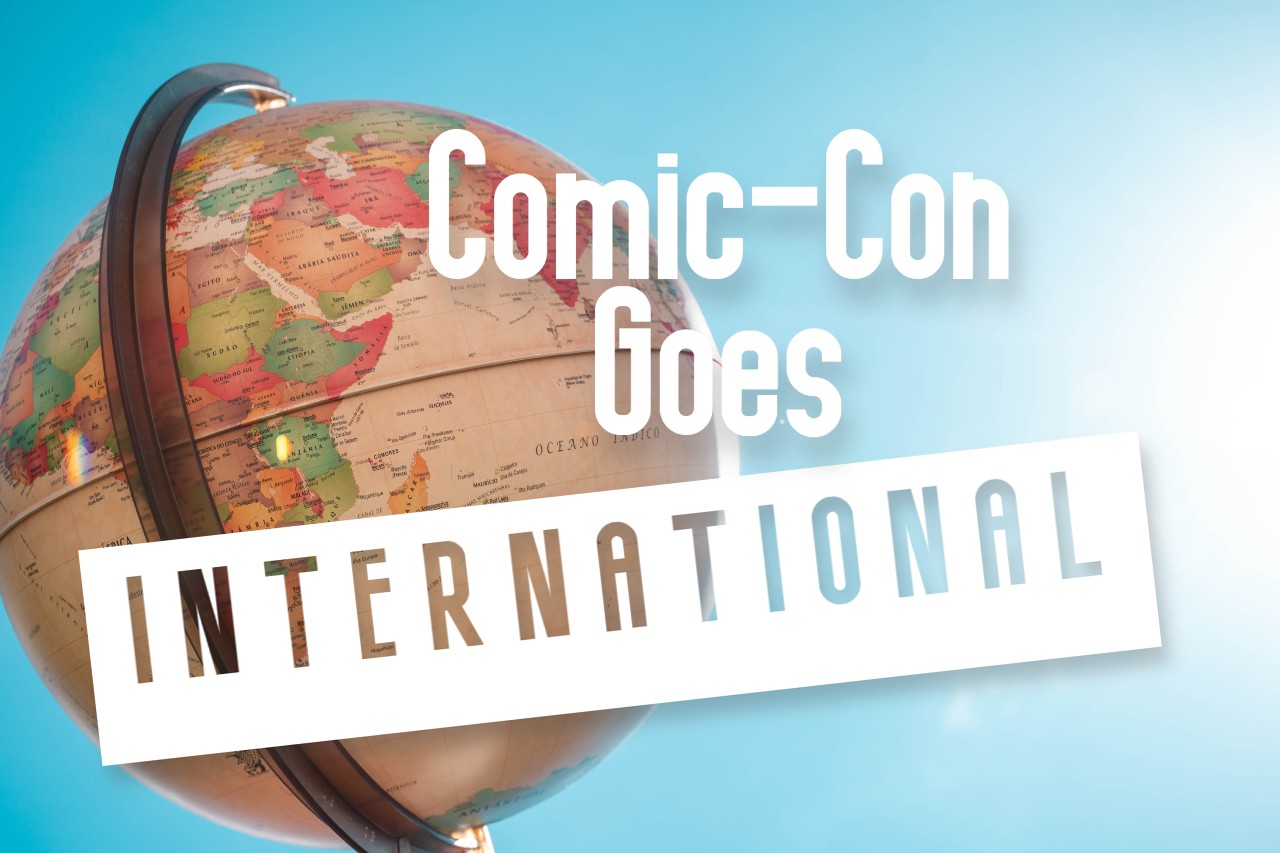Cultural Diversity Shines at SDCC@Home 2021

San Diego Comic-Con has always been a treasure trove of interesting panels. Big studio offerings will always draw the crowds, but every day has its own hidden gems if you find yourself shut out of the big rooms. The past two years, SDCC has done its best to provide us with the same quality, despite being virtual. For SDCC@Home 2021, they branched out and seemed to truly embrace the “International” in Comic-Con International for the first time.
SDCC is an overwhelmingly Western convention (at least on the TV/film side). With the exception of anime programming, the vast majority of studios and projects are American (and predominantly white). In recent years, this has been changing, with numerous panels devoted to Black stories and characters in pop culture and at least one annual panel spotlighting Asian-American representation. SDCC@Home 2021 branched out even further, offering panels on Native American and Mexican culture as well.
All three SDCC@Home 2021 panels are definitely worth a watch in full, but I’d like to highlight some of the topics discussed.
Native Americans in Pop Culture with Taboo
In a one-on-one conversation for SDCC@Home 2021, international comic book historian Jessica Tseang and the Black Eyed Peas’ Taboo (Marvel’s Werewolf by Night) discussed Native American representation in pop culture – from the role models Taboo looked up to as a child to how we can always do better.
“We have all these amazing artists that are coming out that happen to be from Indian country, that are representing a very authentic and genuine voice, but also making it inclusive so everyone can learn and educate themselves and be informed,” Taboo said on the panel. “There’s a lot of misconceptions about Native people not being around. Well, we are. There’s a lot of us out there.”
As for what we can do to improve Native representation in pop culture, Taboo’s suggestion was pretty basic. “Bring in the right people to advocate for [representation]. I think a lot of times, the representation of the actual characters are so overstereotyped and misleading to a modern-day Native. […] In actuality, there’s also cultural consultants that you can bring aboard when it comes to comics, when it comes to television, when it comes to film, that can give you an authentic, genuine representation and a voice that speaks to a modern-day kid and is inclusive to everyone.”
But it isn’t just Native cultures that Taboo champions. He talked about how much Black Panther resonated with him because of what it was able to do for Black stories. Having a film like that – or like Crazy Rich Asians, which was mentioned later on the panel – is important because it brings the cultures to life rather than just having a static character on screen, or something that comes across as inauthentic.
“Whatever Wakanda embodied and how they celebrated and highlighted the beauty of the culture,” Taboo said, “I said, ‘I want to do that for Native people. I want to do that for Mexican people, for Latinos. The same thing with Asians and Filipinos and Middle Eastern and all the beauty that is a mosaic of culture.”
The important thing, Taboo stressed, was to just keep chipping away. Don’t get complacent; don’t assume that just because there have been a few well-written, well-received Native characters means that we’re anywhere close to done. He points to the popularity of Into the Spiderverse as an example of how people will embrace these stories.
“There’s something really special about [Miles Morales], and seeing how we can have different heroes really surfacing and having their proper due that are not, once again, the conventional heroes that we’re used to seeing.”
Video Games, Art, and Mexican Culture
In an SDCC@Home 2021 panel moderated by Hugo Castro (founder and CEO of Gamacon), Guillermo Vizcaino (head of PR & Marketing at Lienzo video-game development studio), Alexis Colin (co-founder & game designer at Seashell Studio), and Kevin Kleinrock (president of Masked Republic) talk about how they are bringing Mexico’s rich history and culture into video games.
Vizcaino, whose Lienzo has put out Mulaka and the upcoming Aztech Forgotten Gods, remarked about how his research about the Tarahumara tribe led him to learning about myths and legends that even he didn’t realize existed. “They have some of the most amazing stories out there. And I would go as far as to say that they’re right up there on par with the Greek and the Roman mythologies, with the Asian, Japanese mythologies, in terms of grandeur and epicness and all that. And no one knows about that. […] Not even us know about them – us within the country. It’s outrageous.”
Meanwhile, Colin’s Lunch A Palooza highlights how there are many different ways that Mexican culture can be brought into gaming. “There is always a different way to bring or share our culture to media, regardless of what the project is about. […] An example is Lunch A Palooza. It’s not a Mexican game – it has different levels from different places. But it has this tiny piece of Mexico. […] I think Mexico is culture, but it’s also all about experiences and emotions.”
Kleinrock’s Project Mask goes in yet another direction, drawing on the history and culture of lucha libre. “We want the game to give people outside of Mexico a history lesson in kind of a fun way,” he said, explaining that even though the game centers on lucha libre, it’s not a wrestling game; there will be a story, and the story takes players to famous cities and locations throughout Mexico and explore the history of the country. “Aztec and Mayan warriors would don masks that represented jaguars and eagles and various other creatures, and that really did play a part in inspiring what became kind of the looks and the world of lucha libre.”
“There’s so much great history and culture in Mexico, and not a lot of it gets explored,” Kleinrock added.
Legacy of Aztec Culture: 500 Years After the Fall
It’s been 500 years since the fall of the Aztec Empire to Spanish invaders. In an SDCC@Home 2021 panel moderated by Anina Bennett, a variety of Mexican and Mexican-American creators with Aztec-themed projects got together to discuss the influence of Indigenous culture and history on their work and how their understanding of Mesoamerican cultures has evolved.
Henry Barajas (Helm Greycastle) talked about the importance of seeing people that looked like him in comics, particularly fantasy. “If goblins and wizards […] can exist, then Mexicans can be in fantasy.”
Guillermo Vizcaino, who was also a panelist on the previously-mentioned Mexican culture panel, discussed the controversy of doing a project revolving around an Indigenous group while not being a member of the group himself. In the end, it was decided that it was worth it. “If we didn’t do it ourselves, then probably no one was going to do it,” Vizcaino said, “and that was going to be a disservice. Because the richness that this mythology has is on par with any other popular mythology out there. […] We couldn’t stand hearing about another Norse-inspired game or Greek- or Roman-inspired game or samurai- or ninja-inspired game and have the world missing something as rich as what the Tarahumara was for us.”
Comics creator Paul Guinan did an insane amount of research for his Aztec Empire, using contemporary historical texts (as in contemporary to Cortés, not contemporary to now) to do a more historically accurate, visual representation of the conflict between the Aztec and the Spanish. (Barajas even cited Guinan’s Patreon as being a great source of information.)
“I became very upset with the mythology that surrounds this event,” Guinan said, “which was created basically by Spanish colonial friars in the 16th century that made up these things about how Cortés was returning Quetzalcoatl and the Aztecs thought the Spanish were gods. That’s nonsense.”
Guinan’s statement perfectly encapsulates the importance of understanding where our interpretation of history comes from. Even if you learned about the Aztec in school (which given the American education system isn’t guaranteed), it is probable that you learned an inaccurate version of what happened.
Barajas expressed surprise at learning that the Aztec believed in magic, as he discovered during his research that Moctezuma sent magicians down to stop the Spanish. “What a horrible time to find out magic isn’t real when these white-skinned bearded men are putting swords into your stomach[…]”
This led to a very interesting discussion on how every society has its different belief systems, and how the Aztec believing in magic is no different than a current society putting its faith in God. Animation producer Sofia Alexander (Onyx Equinox) compared it to a Christian nation getting invaded by aliens. “Some people believe that we are the center of the universe and that God only created humanity and that’s it, but then when they’re confronted with a different reality, I can see how devastating that must be.”
The panelists stressed how important it is to remember that this was a society. In America, we learn a lot about European history but not so much about the history of our own continent, and this is something that should be remedied. The Indigenous peoples of the Americas developed their own societies completely independently of those developed on the other side of either ocean, and they had their own discoveries and advancements the way any other culture did.
“They have this other school of technical and perhaps more landed [scientific] ground-based knowledge that we don’t always give them enough credit for,” said Vizcaino. “[…] Their knowledge in mathematics, in science, in astrology, even in social structure – in urban planning, in architecture – there’s a lot of ground-breaking discoveries that started with Mesoamerican civilizations. […] They were so much more than ‘just a bunch of Indians’ like the Spaniards wanted us to believe.”
Author: Jamie Sugah
Jamie has a BA in English with a focus in creative writing from The Ohio State University. She self-published her first novel, The Perils of Long Hair on a Windy Day, which is available through Amazon. She is currently an archivist and lives in New York City with her demon ninja vampire cat. She covers television, books, movies, anime, and conventions in the NYC area.
Help support independent journalism. Subscribe to our Patreon.
Copyright © The Geekiary
Do not copy our content in whole to other websites. If you are reading this anywhere besides TheGeekiary.com, it has been stolen.Read our






